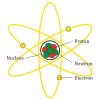Pakistan Atomic Research Reactor
| Pakistan Atomic Research Reactor | ||
|---|---|---|
Cladding Material Aluminium Alloy | | |
The Pakistan Atomic Research Reactor or (PARR) are two
, Pakistan.In addition a reprocessing facility referred to as New Labs also exists for nuclear weapons research and production.
The first nuclear reactor was supplied and financially constructed by the Government of United States of America in the mid 1960s. The other reactor and reprocessing facility are built and supplied by Pakistan Atomic Energy Commission (PAEC) in the 1970s and 1980s, respectively. Supervised by the United States and International Atomic Energy Agency (IAEA), the first two reactors are subject to IAEA safeguards and its inspections.[1]
History of PARR-Reactors
The PARR-I Reactor was supplied by the United States government in 1965 under the
In the first stage, reactor building and ancillary facilities were completed with the reactor becoming critical on 21 December 1965. The second stage, consisting of various laboratories, workshop, library and auditorium, became operational in 1974. The facility was last upgraded by PAEC chairman and noted
PARR-I Reactor
The PARR-I Reactor was the first reactor that was supplied by American Machine and Foundry. Peter Karter had personally supervised the construction of the reactor. The PARR-I is a
The PARR-I Reactor attained its full
The program was carried out to meet demands of
PARR-II Reactor
The PARR-II Reactor is an
4.A PARR-II consists of a core reactor,
New Labs
Unlike the PARR-I and PARR-II the New Labs is not subject to
In the 1960s PAEC contracted the project with
The plant was completed in 1981 and cold reprocessing tests for producing plutonium took place at New Labs in 1986. The New Labs came into limelight when Pakistan had secretly tested its plutonium weapon-based nuclear device in
Charged Particle Accelerator
In early 1983, Pakistani nuclear physicist
The particle facility is designed to implantation of 42+
Fast-Neutron Generator
In 1961, the
References
- google docs).
- ^ Mastermind of the MRF Logsdon, Gene. BioCycle. Emmaus: April 1993. Vol. 34, Iss. 4; pg. 49, ff.
- ^ Pakistan Institute of Nuclear Science and Technology (PINSTECH); Higher Education Commission of Pakistan; Pakistan Atomic Energy Commission. "Pakistan Research Reactor-I" (PDF). PINSTECH, HEC, PAEC. HEC. Archived from the original (PDF) on 3 March 2016.
- ^ "PERFORMANCE OF PARR-1 WITH LEU FUEL". www.rertr.anl.gov. Retrieved 6 April 2022.
- ^ "PARR-I Program Crticallity" (PDF). 1995. Archived from the original (PDF) on 3 March 2016.
- ^ "History -- PINSTECH". Archived from the original on 31 January 2009. Retrieved 6 November 2009.
- PINSTECHand HEC. Higher Education Commission.
- S2CID 99794444.
- ^ Albright, David (1 June 1998), Technical Assessment: Pakistan's Efforts to Obtain Unsafeguarded Plutonium are Nearing Fruition
- ^ "Rawalpindi New Labs - Pakistan Special Weapons Facilities". nuke.fas.org. Retrieved 6 April 2022.
- ^ How Pakistan Made Nuclear Fuel" by Munir Ahmad Khan, former chairperson of the Pakistan Atomic Energy Commission: Islamabad The Nation 7 February 1998, page 7
- ^ a b "-- Facilities -- PINSTECH". Archived from the original on 30 October 2009. Retrieved 3 July 2010.
- ^ a b c d e Fast Neutron Physics Group (FNPG). "Fast Neutron Generator". PINSTECH Institute's Media Research Cell (Note: For more information click on Physics Research Division.). Atomic and Nuclear Radiation Group (ANR Group). Archived from the original on 19 June 2006.
External links
- PARR Reactors
- PARR-I
- PARR-II
- PARR Nuclear Reactors Archived 3 March 2016 at the Wayback Machine

